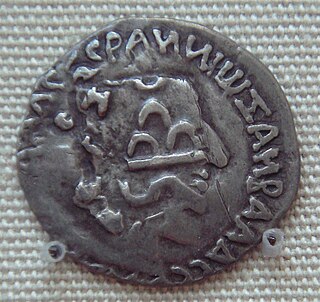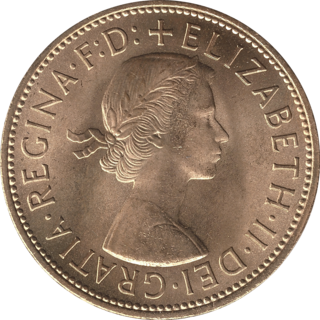
A coin is a small object, usually round and flat, used primarily as a medium of exchange or legal tender. They are standardized in weight, and produced in large quantities at a mint in order to facilitate trade. They are most often issued by a government. Coins often have images, numerals, or text on them. The faces of coins or medals are sometimes called the obverse and the reverse, referring to the front and back sides, respectively. The obverse of a coin is commonly called heads, because it often depicts the head of a prominent person, and the reverse is known as tails.

The birr is the primary unit of currency in Ethiopia. It is subdivided into 100 santims.
Trade dollars were silver coins minted as trade coins by various countries to facilitate trade with countries in East Asia, especially China and Japan. They all approximated in weight and fineness to the Spanish dollar, which had set the standard for a de facto common currency for trade in the Far East.
This glossary of numismatics is a list of definitions of terms and concepts relevant to numismatics and coin collecting, as well as sub-fields and related disciplines, with concise explanations for the beginner or professional.
Irish coins have been issued by a variety of local and national authorities, the ancient provincial Kings and High Kings of Ireland, the Kingdom of Ireland (1541–1801), the United Kingdom of Great Britain and Ireland (1801–1922), the Irish Free State (1922–1937), and the present Republic of Ireland. Since 2002, the Republic of Ireland has minted Euro coins, featuring symbols such as flax and the harp.

In numismatics, token coins or trade tokens are coin-like objects used instead of coins. The field of token coins is part of exonumia and token coins are token money. Their denomination is shown or implied by size, color or shape. They are often made of cheaper metals like copper, pewter, aluminium, brass and tin, or non-metals like bakelite, leather and porcelain.

In numismatics, an overstrike describes a situation in which an existing coin rather than a blank is struck with a new design. This practice is now obsolete and generally occurred for two purposes. Overstriking was sometimes done for technical reasons when a first strike is unsatisfactory, or accidentally if the blank slips out of place or if the dies judder, resulting in a slight doubling of the design. However, sometimes old or worn coins were overstruck with new designs by later rulers or foreign states.

Between 1878 and 1885, the Cochinchina piastre was the currency of the French colony of Cochinchina. It was replaced by the French Indochinese piastre after the creation of a unified administration for Cochinchina and the other French protectorates and colonies in the Far East on 22 December 1885.

The cash or qian was a type of coin of China and the Sinosphere, used from the 4th century BC until the 20th century AD, characterised by their round outer shape and a square center hole. Originally cast during the Warring States period, these coins continued to be used for the entirety of Imperial China. The last Chinese cash coins were cast in the first year of the Republic of China. Generally most cash coins were made from copper or bronze alloys, with iron, lead, and zinc coins occasionally used less often throughout Chinese history. Rare silver and gold cash coins were also produced. During most of their production, cash coins were cast, but during the late Qing dynasty, machine-struck cash coins began to be made. As the cash coins produced over Chinese history were similar, thousand year old cash coins produced during the Northern Song dynasty continued to circulate as valid currency well into the early twentieth century.

A countermarked, punchmarked or counterstamped coin is a coin that has had some additional mark or symbol punched into it at some point after it was originally produced while in circulation. This practice is now obsolete.

Punch-marked coins, also known as Aahat coins, are a type of early coinage of India, dating to between about the 6th and 2nd centuries BC. It was of irregular shape. These coins are found over most parts of subcontinent and remained in circulation till the early centuries CE.

The British pre-decimal penny was a denomination of sterling coinage worth 1⁄240 of one pound or 1⁄12 of one shilling. Its symbol was d, from the Roman denarius. It was a continuation of the earlier English penny, and in Scotland it had the same monetary value as one pre-1707 Scottish shilling. The penny was originally minted in silver, but from the late 18th century it was minted in copper, and then after 1860 in bronze.

Chinese coinage in the Ming dynasty saw the production of many types of coins. During the Ming dynasty of China, the national economy was developed and its techniques of producing coinage were advanced.

The British twopence (2d) coin was a denomination of sterling coinage worth two pennies or 1/120 of a pound. It was a short-lived denomination in copper, being minted only in 1797 by Matthew Boulton's Soho Mint.
The history of Philippine money covers currency in use before the Hispanic era with gold Piloncitos and other commodities in circulation, as well as the adoption of the peso during the Hispanic era and afterwards.

Qing dynasty coinage was based on a bimetallic standard of copper and silver coinage. The Manchu-led Qing dynasty was proclaimed in 1636 and ruled over China proper from 1644 until it was overthrown by the Xinhai Revolution in 1912. The Qing dynasty saw the transformation of a traditional cash coin based cast coinage monetary system into a modern currency system with machine-struck coins, while the old traditional silver ingots would slowly be replaced by silver coins based on those of the Mexican peso. After the Qing dynasty was abolished its currency was replaced by the Chinese yuan of the Republic of China.
Chinese tokens were an alternative currency in the form of token coins produced in China during the late Qing dynasty around the time of the Taiping Rebellion in the province of Jiangsu but not by the Taiping government, which had issued its own currency. Later tokens were again issued in Jiangsu during the Japanese occupation. These tokens were typically made by merchants and local businesses as well as local authorities and had nominal values denominated in their value in cash coins.

The Kan'ei Tsūhō was a Japanese mon coin in use from 1626 until 1868 during the Edo period. In 1636, the Kan'ei Tsūhō coin was introduced by the Tokugawa shogunate to standardise and maintain a sufficient supply of copper coinage, and it was the first government-minted copper coin in 700 years. The government adopted the coin after its successful introduction in the Mito domain ten years prior in 1626, the third year of the Kan'ei era. These coins would become the daily currency of the common people and would be used for small payments.

"Red cash coins" are the cash coins produced in Xinjiang under Qing rule following the conquest of the Dzungar Khanate by the Qing dynasty in 1757. While in Northern Xinjiang the monetary system of China proper, with standard cash coins, was adopted in Southern Xinjiang where the pūl (ﭘول) coins of Dzungaria circulated earlier, the pūl-system was continued but some of the old Dzungar pūl coins were melted down to make Qianlong Tongbao (乾隆通寶) cash coins. Because pūl coins were usually around 98% copper, they tended to be very red in colour which gave the cash coins based on the pūl coins the nickname "red cash coins".

Countermarked yen refers to Japanese trade dollars and 1 yen coins that are stamped 銀, literally meaning "silver". The countermark was added by the Japanese government in 1897 to these coins dated up to that point. This came at a time when Japan went onto the gold standard prompting the government to confine these two denominations for use outside the mainland. Due to their eye appeal, these coins are now regarded as collectibles by preference.


















